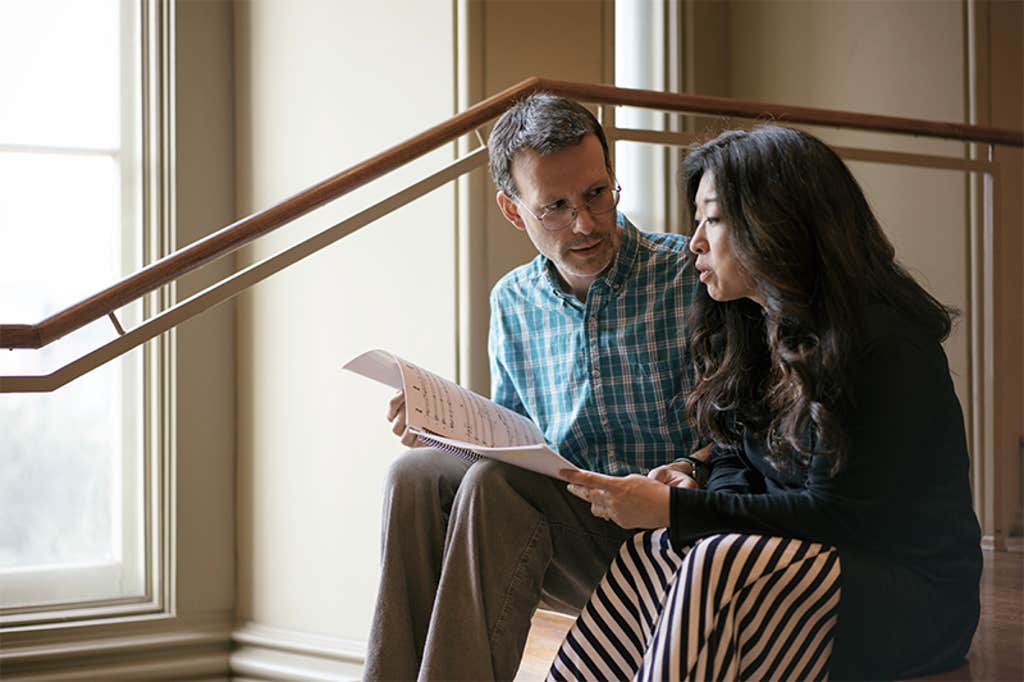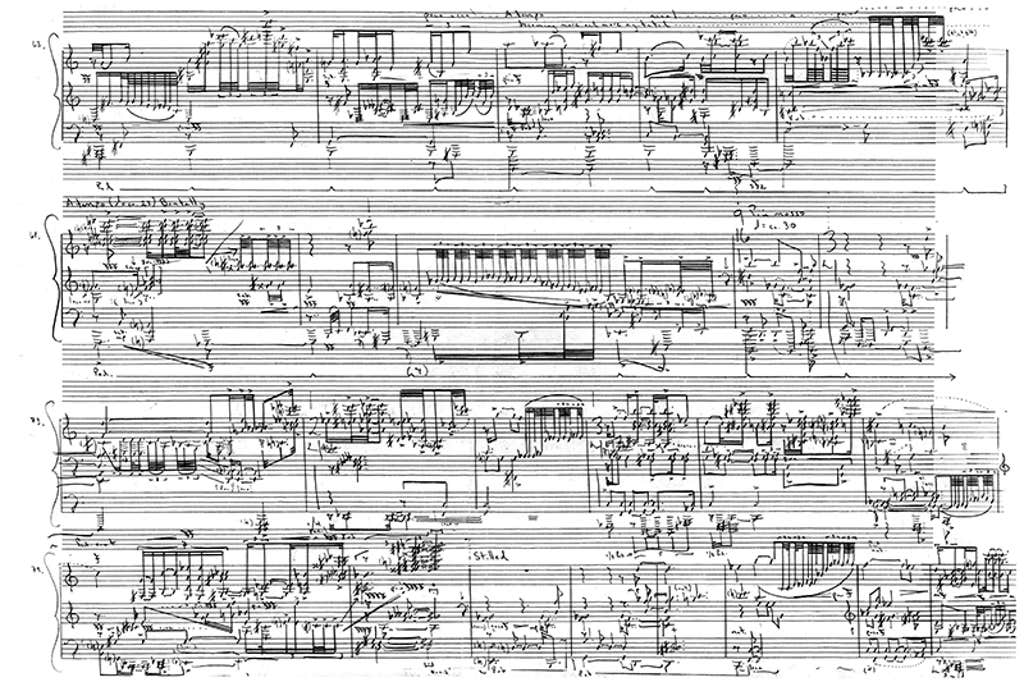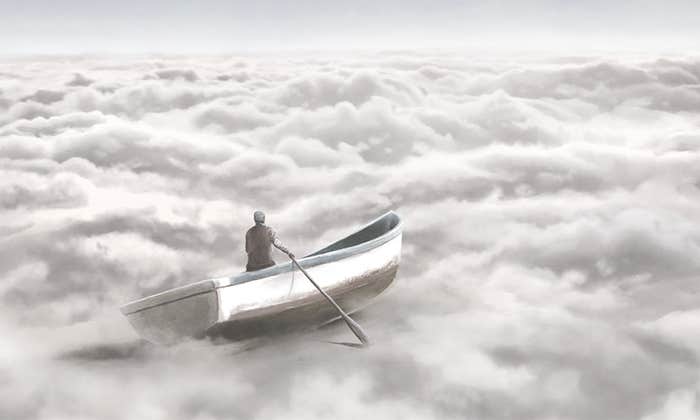“… a few uncontrolled screams—in our stride”
—Robert Lowell
Early last year, I experienced a health emergency. The medical discharge report read in part, “You experienced an out-of-hospital cardiac arrest … fortunately you were able to be revived.”
I appreciate the conciseness and lack of drama in this description, something the late poet and painter Fawzi Karim once addressed in relation to reality in art and the pursuit of it:
As a consequence of being here, I have become very close to the idea of the simple sentence, one in which there is no exaggerated feeling or idea or belief. It is better to leave things just as they are. Once you add these other things you misjudge, you become unjust.1
It was my daughter who found me collapsed in our kitchen. I don’t remember the legion of emergency personnel who came into our house attempting to revive me, the activity, the noise, the medical detritus left behind, the neighbors no doubt gathered outside awaiting a glimpse of the person who inevitably would be brought out on a stretcher, necks craning in a search for answers as happens in a neighborhood when something out of the ordinary breaks the silence. I don’t remember anything of the next five or so days, or anything in the 24 hours prior to the event. The entire experience is difficult to piece together. What is primarily left for me is the face of my daughter recounting the experience.
At some point in the days after admittance, I self-extubated in the I.C.U. After regaining consciousness, I was in a state of bewilderment, pain, and confinement. I had breathing difficulties due to blood in the lungs, perhaps a laryngeal injury caused by my inexpert and violent removal of the breathing tube. It wasn’t entirely clear to me what was happening.
Someone asked what I was “after” in my work; what did I hope to achieve?
I slowly retrained my senses to the realities around me, moving through the weeks that followed with at once lucidity and a structural sense of disconnectedness, both states co-existing in an effort to return to a meaningful normalcy. The most terrifying part of the ordeal was not, in fact, landing on that line between life and death, but simply the lack of agency and day-to-day clarity during that emergent period upon stepping back from it; restriction, confusion, and misapplication of power reigning overall. These things still haunt.
On reflection, I have discovered that my attitudes toward work, toward composing and the internal momentums therein, remain similar to how I felt about these things before the cardiac arrest. This is a bit surprising, in that there is some expectation one should, perhaps, approach things differently after what are at least outwardly transformative and demarcating experiences. While it is unclear to me whether I have moved forward as an artist, I have in the past year, however, found myself in new territories of deliberateness—concurrent, energized states of cognizance and intuitiveness, composure and presentiment—and a yielding, perhaps (perhaps not), of new ways of hearing, of seeing. I feel, imagine, a renewed sense of resoluteness.

The truth about the world … is that … had you not seen it all from birth and thereby bled it of its strangeness it would appear to you for what it is, a hat trick in a medicine show, a fevered dream, a trance bepopulate with chimeras having neither analogue nor precedent, an itinerant carnival, a migratory tentshow whose ultimate destination after many a pitch in many a mudded field is unspeakable and calamitous beyond reckoning.
—Cormac McCarthy, Blood Meridian
Someone recently asked what I was “after” in my work; what did I hope to achieve? It seems a simple enough question. But beyond what has for much of my life felt a desperate urgency to write music, the excitement in attempting to capture a moment, a situation, a state of mind, a state of being, aliveness, trying to reach for a succinct answer to this question in conversation is difficult.
The answers I generally arrive at feel like weak attempts at characterizing something for which the work itself holds the answers. I do know that in the work to which I respond of other artists there is always an omnipresent exigency, even in the stillest, most delicate moments; palpability, something convincingly messaged through the art directly, even if it is difficult to capture in discussion; and above all, fearlessness, a clear willingness to proceed no matter the destination.
Reflecting on the death of a dear friend, I characterized the period thereafter as akin to being caught in an undertow. Even when regaining a sense of control, a distance and reemergence from the currents, I would inevitably and predominantly be pulled back to places of grief and disquiet. The relentlessness of return seems at times a kind of constitutional inability to fully come to terms. Perhaps this is more common than many wish to believe, a permanent, indestructible irresolution. Looking back upon my own work, a confrontation with irresolution seems to comprise in large part the engine which propels me to wrestle with these things, in this case through the prism of music.

There also is a recurring engagement with varying forms of violence in my work, violences at the core, or at least at the origin points of the musical exploration. At times, the violence is within (illness), at times without (violence inflicted by one person or groups of people against another or others).
The world of illness has shaped and informed my monodrama On the Threshold of Winter, and the elegy, I hope we get a chance to visit soon, these works engaging with loss to cancer, and to a lesser extent my own direct experiences with the disease. Examples of violences from without include my two recent operas: Poppaea and Medea, and a work for unaccompanied violin, the weather and landscape are on our side, a cycle loosely structured on some of the last correspondence of writer and artist Bruno Schulz, who was shot on the street by a Nazi officer in 1942.
There are certainly many instances where disquiet—that structural irresolution and a confrontation with these states that I am attempting to give shape to—presents as more environmental or atmospheric, a musical argument which is divorced from any explicit narrative or event. In struggling to quantify my most recent opera, and we, each, I have written that the work is above all an exploration of the treacherous territories of relationships—between individuals, within societies and, ultimately, the collapse of both. The opera is based upon texts by poet Shane McCrae. From the last scene, McCrae writes:
… The couple stretched and broke …
… world in world … chaos flung on bones …
… where I meet you, we are here.
When asked questions of motivation, and when considering the broad topic of reality, I am reminded of painter Francis Bacon’s “brutality of fact.” Bacon, responding to the notion that many perceive his work as horrific, said, “I’ve always hoped to put over things as directly and rawly as I possibly can, and perhaps if a thing comes across directly, they feel that that is horrific.”2
I also think of something my friend, sculptor Christopher Cairns, has repeated over the years. He likes to quote painter Eugène Delacroix, who reportedly said he “liked the look of fresh blood.” Cairns feels Delacroix must have meant he was attempting to “get at reality,” that he was struggling to “get at something real” in his art.
Again, Cormac McCarthy in Blood Meridian:
They found the lost scouts hanging head downward from the limbs of a fireblacked paloverde tree. They were skewered through the cords of their heels with sharpened shuttles of green wood and they hung gray and naked above the dead ashes of the coals where they’d been roasted until their heads had charred and the brains bubbled in the skulls … Their tongues were drawn out and held with sharpened sticks thrust through them and they had been docked of their ears and their torsos were sliced open with flints until the entrails hung down on their chests. Some of the men pushed forward with their knives and cut the bodies down and they left them there in the ashes.
Critic Caryn James, reflecting on McCarthy’s broader motivations, writes that “McCarthy has asked us to witness evil not in order to understand it but to affirm its inexplicable reality.”3
This reality need not be the nightmarish, grim, complex worlds explored by McCarthy, though it commonly is. In my experience, the nature and work of an individual is frequently shaped more by the tragedies that befall them than by anything else, and the beautiful, the just moments in and of one’s life are often, if not inevitably, contoured by those darknesses.

I was barely a year old when my 23-year-old aunt was killed in an accident. In later years, I would wonder how this event shaped my mother and her subsequent choices, the loss of her sister reminding her of reality in the starkest of terms at a relatively young age, the tangible knowledge that catastrophe is likely taking shape just over the horizon, just out of sight, but remaining diffused enough to silence or mask, only for a time, the threat. She suffered from bouts of intrusive anxiety that would constrain her life in various ways, but she always impressively overcame the obstacles that afflicted her, or for the most part seemed to.
Then, not long after the loss of her sister, her father died, a second trauma for her and for the family; catastrophe’s form having gathered and deployed once again. During his illness, my parents decided to send me to live with him during the period he underwent treatments. The seemingly relentless doctor and hospital visits unnerved me, but I wasn’t frightened for his imminent absence. This possibility didn’t occur to me. He exuded strength and permanence. I never sensed he was dying, though he did soon after. When I went through my own cancer treatments almost 30 years later, I tried to summon his courage, or what seemed a courageousness reflected through the eyes of a 7-year-old boy.
The last visit I had with my dear friend, mentioned earlier, brought again into question my grasp of the realities around me, though without the excuse of childhood misapprehensions. Looking back now, I realize she was of course very near death. This was reflected in all aspects of her presence: her voice, her appearance, her almost fantastical and fanatical sense of optimism. But she was so persuasive in her optimism that she convinced me she would go on, she would continue to survive as she had done again and again.

For a time our treatments overlapped. We went through a period when our varying cancer treatments were occurring simultaneously (though different cancers in different parts of the country). While I was mainly left with physical disfigurement, pain, anger, and speculation, these all-too-common things paled in the face of her death and the remaining questions thereafter.
She died in 2009, age 45. There has remained for me since her death a certain emotional defacement resulting from the miscalculation of not recognizing how near death she was at that time, the regret of not seeing what was right there in front of me.
The irresolution I often feel and recognize in the art to which I respond is, perhaps, as an acute grief which can take on the quality of amber-like immutability, a state never truly able to be moderated, only (often feebly) covered over. The attempt, though, to transform, to scrutinize, to break through, in my case to endeavor through music, is often terribly exciting. This I believe, even if eventually doomed, is the major propellant for my work. From the beginning, I have attempted to shape musical drama without obfuscation, without missing or passing by those things I wish to explore, though often difficult. I also recognize that some of the most beautiful art finds its beauty in the veneer, the facade, the mask, the shell. I, however, have generally been drawn to what is behind the bandages.

Almost 25 years ago, I attended an exhibition in Rome of Michael Mazur’s The Inferno of Dante, a series of 41 etchings with accompanying texts of Dante in a translation by Robert Pinsky. It was a deeply moving experience. Mazur and I spoke, and soon after I performed a number of my works for him at the piano. A few years later, when my first recording of solo and chamber music was released, Mazur wrote a program note for it. Although I feel now very far from those works, as one does when time wrenches us forward and we find ourselves at a distance, Mazur’s words linger and remain present for me:
There is … the overwhelming sense of “sadness,” which is better than “doom.” In fact, the abyss in its finality is easy to portray: a rich black says it all. Dante is often thought to have made his poem [Inferno] about doom and punishment for sin. He looked into the abyss but primarily found sadness there. Sadness is a much more complicated and, therefore, interesting human condition. It is harder to portray visually.
I would make the case that this is similar in music. Mazur continued:
These compositions are filled sometimes with frightening sounds. They are unrelenting, nearly without hope … But no artwork can be without hope since it is in the very nature of creative work to be optimistic, if only in as much as we continue to work through everything but our own death.4
Approximately a decade after our initial meeting, I intersected with Mazur’s artwork musically for the first time, resulting in a piece which is one of the only works I’ve written where both of the earlier noted elements of internal and external violences overtly collide. The piece is a string quartet titled Images from a Closed Ward, a 13-movement cycle completed the year after Mazur’s death in 2009. The origin point for the quartet was Mazur’s “Locked Ward” series of images, a collection which struck me as a kind of real-world embodiment of much of what I had seen years before in his Inferno imagery.
The artwork confronts the horrors of mental health treatment as Mazur witnessed it during the 1960s. In an interview with Cherie Doyle Riesenberg in 1988, Mazur relayed an anecdote regarding an early confrontation with a reality that fundamentally changed his approach to making art. He was 19 and was singing popular songs with a group of friends for women in a secured unit of a veteran’s hospital. In the midst of the performance, one of the soloists was violently attacked on the stage. Mazur noted, “I never forgot that. It was the first meeting with reality, with the darkest kind of reality.”
In her book, Robert Lowell: Setting the River on Fire, psychologist Kay Redfield Jamison references art and truth in her writings on the 20th-century poet, though I think her utilizations of these terms are interchangeable with the term “reality.”
To create … art requires toughness, eyes that do not avert their gaze … that [do] not back away from the great, hard subjects: love, betrayal, suffering, madness, war, death. Truth is not always an uplifting thing; human nature is flawed … It is not for the faint of heart. Art is the “ruthless cutting edge that records and celebrates and prophesies on the stone tablets of time,” wrote the Scottish poet George Mackay Brown. Lowell, who spent time with Brown on his late-life trip to Orkney to trace the ancestral roots of his poetry and his own madness, put it plainly. “We must all live by taking a few uncontrolled screams—in our stride.”5
Perhaps somewhere in those screams is the something “real” that Cairns and Delacroix are talking about. Each of these artists, Lowell and McCarthy included, attempt to engage with and make sense of the world around them, the world as they see it with no attempt to anesthetize or becloud it. The work these artists create, that I am attracted to, does not shy away from, nor attempt to escape this world, as difficult and as ferocious as it can be. There seems little interest in constructing opacity.
What I respond to in artists is fearlessness, a clear willingness to proceed no matter the destination.
However, that notion of disquiet, the human difficulties often traversed in their work, are not devoid of those things one might characterize as beautiful; fully, absolutely, beautiful. Responding to negative reactions to his often-graphic work, painter Hyman Bloom stated his hope was to somehow bring a clear unity to the “harrowing and the beautiful.”6
Karim’s approach to his work, his appeal to “the simple sentence,” of “no exaggerated feeling or idea or belief,” that it “is better to leave things just as they are,” is something I obsess over. In my own conversations with Karim, the idea of simplicity has nothing to do with an absence of complexity; it is about fidelity to one’s ideas, specifically what the artwork at hand requires, unto itself. This ultimately becomes something which relies on an instinct: an intuitive signal that the “reality” of the piece has been identified and engaged with. It is a search for a dignity in the essence of the piece. This dignity doesn’t refer to the overlooking of fear, of humiliation, degradation, the profane; things from which we might instinctively recoil. It is simply that whatever is being said is expressed with an ultimate clarity, a precision, the realities surrounding us in direct confrontation with the senses and imagination. It is a journey, above all, to simply get to the heart of the matter.

It was when darkness crept in and far below me
I saw the roof of my house, saw the shadows falling …
so soundlessly I glided, scarcely moving a wing,
high above the earth.
—W.G. Sebald

In 2016, I completed sew me into a shroud of leaves, a cycle of three works comprising 153 movements and lasting some 10 hours of performance time. While my work has changed since then, with a shift primarily to works for the theater and the voice, the cycle is in certain respects a catalog of my priorities, observations, shifting perspectives, above all, experiences, across a finite span of time, namely the 15 years it took me to complete the trilogy, which I began in 2001.
Poetical fragments and textual connections from three different poets are interleaved throughout each of the cycle’s sections. Here I am not attempting to render these particular texts into music. Rather, I feel the texts share some expressive sensibility with the music, which is why they came to mind in the first place. They are more companions than anything else. The first part of the cycle intersects with the poetry of Christopher Middleton (the second with W.G. Sebald, the third with Marius Kociejowski). Oftentimes, there is a shocking juxtaposition of everyday circumstance and violence in Middleton’s work in particular. In his “Gentle Reader,” Middleton writes:
… Oboe, flute, and strings deliver from the air
Just such a picture, like a Claude Lorraine.
Another fifty years—with different trees
The picture will be mistier, Corot …
Andrew Farach-Colton has noted, “the poet suggests that we, the gentle readers of the poem’s title, are ‘greedy’ for aural and visual images. And then, later in the poem, in an abrupt shift, there are the images and sounds we turn away from. Middleton wants us to see these, too, and to hear”7:
… the shouts of thugs
Clubbing to death with crowbars people
Rather shocked to find that this was happening
A few doors only from home, for no good reason …8
The last movement of Part I is paired with the only complete poem of this first part of the cycle, Middleton’s “Something Vesperal.”9 Interestingly, this example turns away from much of the confrontational darknesses explored by many of the artists I have referenced, including Middleton himself. This text communicates his characteristically elusive beauty:
Spectres, vast, remote,
Uneasily wagging their heads
In shrouds of crushed amethyst:
Tomorrow I will confirm
That they are hill crests,
And slopes parade the green oak, olive,
Serried cherry.
On sunken pots of Rome
An iridescence, thick
Or light, signifies the human:
Should the moment return
At sundown’s onset
I will ask what is this colour,
Again a few score of breaths,
And scaling the underside
Of pine branches
An aqueous rose, diffused.
Neither quality, nor adjunct.
How long so old.
While the reassuring, the inspiriting, and the consoling are explicably attractive, and their powerful grip is obvious, it is also important, perhaps more important than ever, to gaze squarely into and to not turn away from the “unspeakable,” the “mudded field” to which McCarthy draws attention—a field which all too often crashes into our respective spaces. Whether acutely present, looming nearby, or quietly stalking the distance, these places are with us as well, allowing us to feel at the outer limits of that which our capacities provide, to attempt to make sense of this world and the realities therein. ![]()
Lead image: Mike Maguire
References
1. Kociejowski, M. God’s Zoo: Artists, Exiles, Londoners Carcanet, Manchester, U.K. (2014).
2. Francis Bacon in conversation with David Sylvester, Fragments of a Portrait; directed by Michael Gill, BBC (1966).
3. James, C. Is everybody dead around here? The New York Times (1985).
4. Michael Hersch: Chamber Music Vanguard Classics; booklet notes by Nicholas Dawidoff & Michael Mazur, String Soloists of the Berlin Philharmonic/Michael Hersch, piano, (2003).
5. Redfield Jamison, K. Robert Lowell: Setting the River on Fire Knopf, New York, NY (2017).
6. Dervaux, I. Color and Ecstasy: The Art of Hyman Bloom The National Academy of Design, New York, NY (2002).
7. Michael Hersch: The Vanishing Pavilions Vanguard Classics / Musical Concepts, Michael Hersch, piano. Booklet notes by Andrew Farach-Colton. Original Release Date: 2007. Reissued on New Focus Recordings (fcr335), (2022).
8. Middleton, C. The Word Pavilion and Selected Poems Carcanet, Manchester, U.K. (2001).
9. Middleton, C. Collected Poems Carcanet, Manchester, U.K. (2008).
You can listen to some of the works mentioned in the article here.




























